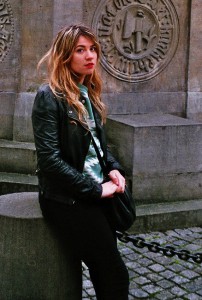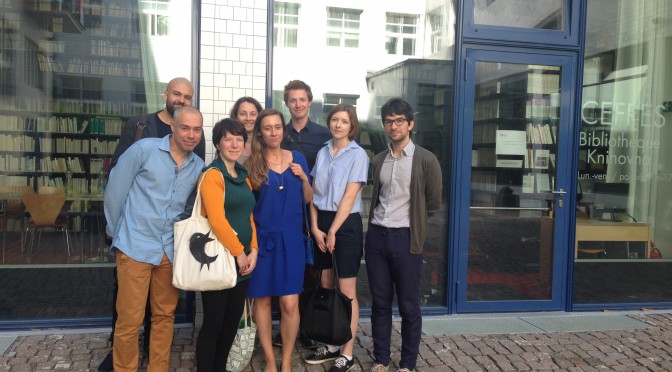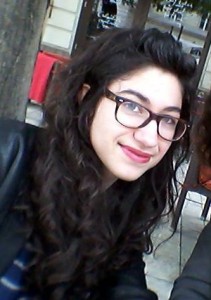Clara Zgoła
 PhD candidate in Art, Language and Cultural studies – School for Advanced Studies in the Social Sciences/University of Warsaw
PhD candidate in Art, Language and Cultural studies – School for Advanced Studies in the Social Sciences/University of Warsaw
Research field: cultural, urban and literary studies, history of art, cultural history (20th-21st centuries), anthropology
Dissertation title: “Literary Explorations of the City: Parisian Identities of Contemporary Novelists”
Period of internship: July 2017
Research interpship
Eva Krejčová
 Master in Politic Theory, Faculty of Arts, Charles University / Master in Comparative Politics, Sciences-Po Paris
Master in Politic Theory, Faculty of Arts, Charles University / Master in Comparative Politics, Sciences-Po Paris
Research fields: political parties, elections, voting systems
Period of internship: June 2017
Administrative internship
Kévin Leuret
 Master in Culture and society, 16th-21st century, faculty of human sciences, University of Bourgogne
Master in Culture and society, 16th-21st century, faculty of human sciences, University of Bourgogne
Research field: French-Czech relations from 19th century until today
Thesis subject: L’Alliance Française, a Mediator of French culture in Czech lands 1886–1938
Internship period: May 2017
Research internship
Renata Jardin Kocourek
PhD student in social psychology – Charles university, faculty of philosophy
Domain of research : The social representation of motherhood in european context
Period of internship : May 2017
Research and administrative internship
Alžběta Stančáková
 Master: comparative literature, Faculty of Arts, Charles University in Prague
Master: comparative literature, Faculty of Arts, Charles University in Prague
Research field: poetry (Romanian avant-garde in France), Prague architecture
Period of intership: may—june 2017
Administrative internship
Carole Benoit
Master Information-Communication speciality esDOC (Documentation, Library, Monitoring) – University of Poitiers
Research fields: digital humanities, research data processing, technical and scientific information, global cooperation
Period of internship: April-June 2017
Administrative internship
Aurore Lafforest
Master in Public Administration – Lyon 2 Lumière University – France
Research field: Transnational Cooperation and science diplomacy
Subject of master thesis: Central Europe : the influence of science diplomacy and transnational cooperation in the process of European integration
Period of internship: from march to june 2017
Research internship
Markéta Jirkovská
MA Interpreting: English-Czech, French-Czech, Institute of Translation Studies, Faculty of Arts, Charles University in Prague
Domain of research: translation, interpreting, intercultural communication
Period of internship in CEFRES: March – April 2017
Administrative internship
Marie Šindelářová
Master Translation and Interpretation – Charles University, Prague
Research field: translation Czech-French
Period of Internship: february – april 2017
Administrative Internship
Kateřina Vorlická
Master Interpreting: French and Czech, English and Czech; Faculty of Arts, Charles University in Prague
Fields of research: interpreting in intercultural communication
Internship Period: February-April 2017
Administrative internship (interpreting)
Cécile Poulot
 PhD student in German studies – University of Paris 3 Sorbonne Nouvelle
PhD student in German studies – University of Paris 3 Sorbonne Nouvelle
Research fields: German and European cultural history, history of art and architecture
Thesis subject: “Adolf Loos: a Viennese architect with a Connected Career Interwar Europe”
Internship period: February-March 2017
Research internship
Elisa Chazal
 Master History Civilization Patrimony – University Jean Monnet of Saint-Etienne / Bachelor of History – University Jean Monnet of Saint-Etienne
Master History Civilization Patrimony – University Jean Monnet of Saint-Etienne / Bachelor of History – University Jean Monnet of Saint-Etienne
Field of research: patrimonialisation, history, local memory
Subject of master thesis: Patrimonialisation of buildings of the world exhibition of Prague in 1891
Period of internship: November—January 2016/2017
Administrative internship
Margot Creach
Maste r Tema EHESS/ FF UK/ELTE
r Tema EHESS/ FF UK/ELTE
Bachelor in History at the University Pierre Mendès-France in Grenoble
Fields of research: heritage, patrimonilaisation, Jewish community
Master’s thesis topic: Heritage as Expression of Jewish History: Walking Tours in Le Marais
Internship Period: October—November 2016
Administrative internship
Nicolas Ausello
 Master’s degree in Territorial Management of Sustainable Development at Bordeaux Montaigne University / Bachelor of geography – Governance at Lumière Lyon 2 University.
Master’s degree in Territorial Management of Sustainable Development at Bordeaux Montaigne University / Bachelor of geography – Governance at Lumière Lyon 2 University.
Fields of research: Urban and environmental policies. European politics on a local scale, cartography and GIS. Environment.
Master’s thesis topic: The Uncertainty of Public Spatial Data : their Valuation by the Private Sector for the Land Sector.
Internship period: October—December 2016










